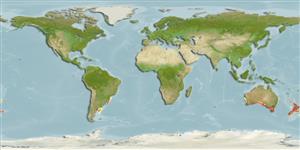Environment: milieu / climate zone / depth range / distribution range
Ecologia
marino demersale; distribuzione batimetrica 22 - 450 m (Ref. 58489), usually 100 - 250 m (Ref. 3243). Subtropical; 27°S - 48°S, 62°W - 176°W
Indo-Pacific: St. Paul and Amsterdam islands in the Indian Ocean, southern Australia, including Tasmania, and New Zealand. Southwest Atlantic: southern South America.
Length at first maturity / Size / Peso / Age
Maturity: Lm 30.0, range 25 - 35 cm
Max length : 70.0 cm TL maschio/sesso non determinato; (Ref. 9563); common length : 35.0 cm TL maschio/sesso non determinato; (Ref. 3243); peso massimo pubblicato: 2.9 kg (Ref. 6390); Età massima riportata: 50 anni (Ref. 26998)
Spine dorsali (totale): 17 - 18; Raggi dorsali molli (totale): 25-28; Spine anali 3; Raggi anali molli: 14 - 15; Vertebre: 35. Adults have elongate upper pectoral-fin rays and are silvery with a broad black band from the nape to the pectoral-fin base (Ref. 33616).
Adults demersal on the continental shelf and upper slope (Ref. 9563) to depths of 450 m (Ref. 33616). Juveniles tend to live near shallow reefs (Ref. 6390). Postlarvae inhabit offshore waters and are found in surface waters at night (Ref. 9072). Average weight is 1800 g. Feed on polychaete worms, crustaceans, mollusks and echinoderms (Ref. 28626). Flesh is quite good eating. Often sold as tiki fillets.
Jackass morwong have an extended pelagic postlarval stage (Ref. 6390). Research in New Zealand has shown that metamorphosis to the juvenile stage occurs between 9 and 12 months after hatching (Ref. 28625).
Kailola, P.J., M.J. Williams, P.C. Stewart, R.E. Reichelt, A. McNee and C. Grieve, 1993. Australian fisheries resources. Bureau of Resource Sciences, Canberra, Australia. 422 p. (Ref. 6390)
IUCN Red List Status (Ref. 130435)
Threat to humans
Harmless
Human uses
Warning: mysqli::__construct(): (HY000/1040): Too many connections in /var/www/html/includes/func_getlabel.php on line 46
Can't connect to MySQL database (fbapp). Errorcode: Too many connections
